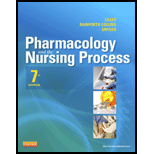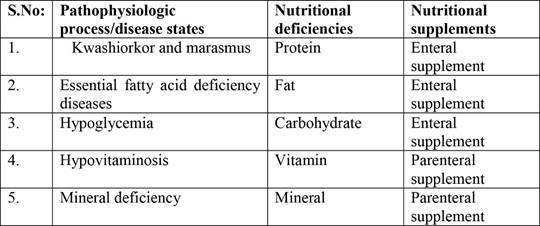
To describe:
The various pathophysiologic process and/or disease states that lead to nutritional deficiencies and require nutritional supplemental support.
Concept introduction:
Nutrients are essential for the cell division and growth, protein, fat, and carbohydrate synthesis, hormone secretion, contraction of muscles, and all other biological processes of the human body. Malnutrition is a condition in which adequate nutritional needs not met by the body to do essential activities of the body. Malnutrition causes many nutritional deficiencies diseases that can be controlled by providing adequate nutritional supplements. Nutritional supplements are made for order particular disease states.
Explanation of Solution
Nutritional supplement can be classified as enteral nutrition and parenteral nutrition based on the mode of administration. Enteral nutrition is the administration of nutrients or food through the gastrointestinal tract. Parenteral nutrition is the administration of nutrients through intravenous.

Thus the pathophysiological process or disease states that lead to nutritional deficiency and requirement of nutritional supplements are discussed.
Want to see more full solutions like this?
Chapter 55 Solutions
Pharmacology and the Nursing Process
- Please answer all questionsarrow_forwardCATH LAB FUNDAMENTALS I WORKSHEET #3 Patient #1 AO 113/68 M CaO2 mi/L LV 113/15 CvO2 ml/L RA M9 C.O. L/Min RV 33/8 S.V. PA 33/16 M C.I. ml/beat L/Min/M2 PAW M 17 S.I. ml/beat/M2 Hgb 15.1 S.V.R Dynes/sec/cm³ Hct % T.P.R Dynes/sec/cm³ PA Sat 69% P.V.R Dynes/sec/cm³ AO Sat 90% BSA M² HR 83BPM 02 Cons. _215_ml/min Ht _5_ft_5_in Wt. _213_ lbs Patient #2 AO 155/92 M CaO2 ml/L LV 155/21 CvO2 ml/L RA M 12 C.O. L/Min RV 41/22 S.V. ml/beat PA 41/20 M C.I. L/Min/M2 PAW M 20 S.I. Hgb S.V.R Hct 39 % T.P.R ml/beat/M2 Dynes/sec/cm³ Dynes/sec/cm³ 3 PA Sat 65 % P.V.R Dynes/sec/cm³ AO Sat _91 % BSA M² HR 88 BPM 02 Cons. 360 ml/min Ht 5 ft 11 in Wt. 169 lbs NAME:arrow_forwardCATH LAB FUNDAMENTALS I WORKSHEET #1 Patient #1 AO 151/89 M CaO2 mV/L LV 151/25 CvO2 mV/L RA M 17 C.O. L/Min RV 61/17 S.V. ml/beat PA 61/25 M C.I. L/Min/M2 PAW M 25 S.I. ml/beat/M2 Hgb S.V.R Dynes/sec/cm³ Hct 45% T.P.R Dynes/sec/cm³ PA Sat 68% P.V.R Dynes/sec/cm³ AO Sat 92% BSA M² HR 89 BPM 02 Cons. 245 ml/min Ht _5_ft_7_in Wt. _235 lbs Patient #2 AO 121/61 M CaO2 ml/L LV 151/19 CvO2 ml/L RA M 15 C.O. L/Min RV 51/15 S.V. ml/beat PA 51/20 M C.I. L/Min/M2 PAW M 19 S.I. ml/beat/M2 Hgb 15.2 S.V.R Dynes/sec/cm³ Hct % T.P.R Dynes/sec/cm³ PA Sat 76% P.V.R Dynes/sec/cm³ AO Sat 99% BSA M² HR 79 BPM Ht 02 Cons. 213 ml/min _5_ft_10 in Wt. _ 185 lbs 1arrow_forward
- CATH LAB FUNDAMENTALS I WORKSHEET #1 Patient #1 AO 151/89 M CaO2 mV/L LV 151/25 CvO2 mV/L RA M 17 C.O. L/Min RV 61/17 S.V. ml/beat PA 61/25 M C.I. L/Min/M2 PAW M 25 S.I. ml/beat/M2 Hgb S.V.R Dynes/sec/cm³ Hct 45% T.P.R Dynes/sec/cm³ PA Sat 68% P.V.R Dynes/sec/cm³ AO Sat 92% BSA M² HR 89 BPM 02 Cons. 245 ml/min Ht _5_ft_7_in Wt. _235 lbs Patient #2 AO 121/61 M CaO2 ml/L LV 151/19 CvO2 ml/L RA M 15 C.O. L/Min RV 51/15 S.V. ml/beat PA 51/20 M C.I. L/Min/M2 PAW M 19 S.I. ml/beat/M2 Hgb 15.2 S.V.R Dynes/sec/cm³ Hct % T.P.R Dynes/sec/cm³ PA Sat 76% P.V.R Dynes/sec/cm³ AO Sat 99% BSA M² HR 79 BPM Ht 02 Cons. 213 ml/min _5_ft_10 in Wt. _ 185 lbs 1arrow_forwardCATH LAB FUNDAMENTALS I WORKSHEET #6 Patient #1 AO 199/110 M CaO2 ml/L LV 199/24 CvO2 ml/L RA M 16 C.O. L/Min RV 41/16 S.V. ml/beat PA 41/25 M C.I. L/Min/M2 PAW M 24 S.I. ml/beat/M2 Hgb 15.1 S.V.R Dynes/sec/cm³ Hct % T.P.R Dynes/sec/cm³ PA Sat 71% P.V.R Dynes/sec/cm³ AO Sat 96% BSA M² HR 61 BPM 02 Cons. Ht 216 ml/min 4_ft_11_in Wt. _171_lbs Patient #2 AO 101/62 M CaO2 ml/L LV 101/12 CvO2 ml/L RA M 5 C.O. L/Min RV 20/5 S.V. ml/beat PA 20/10 M C.I. L/Min/M2 PAW M 12 S.I. ml/beat/M2 Hgb S.V.R Dynes/sec/cm³ Hct 43% T.P.R Dynes/sec/cm³ PA Sat 75% P.V.R Dynes/sec/cm³ AO Sat 97% BSA M² HR 68 BPM O2 Cons. 235 ml/min Ht _5_ft_5 in Wt. 145 lbsarrow_forwardCATH LAB FUNDAMENTALS I WORKSHEET #5 Patient #1 AO 112/63 M CaO2 ml/L LV 112/12 CvO2 ml/L RA M 8 C.O. L/Min RV 25/8 S.V. ml/beat PA 25/13 M C.I. L/Min/M2 PAW M 13 S.I. ml/beat/M2 Hgb 14.8 S.V.R Dynes/sec/cm³ Hct % T.P.R Dynes/sec/cm³ PA Sat 76% P.V.R Dynes/sec/cm³ AO Sat 96% BSA M² HR 82 BPM O2 Cons. 241 ml/min Ht _5_ft_9_in Wt. _180 lbs Patient #2 AO 140/82 M CaO2 ml/L LV 140/15 CvO2 ml/L RA M 12 C.O. L/Min RV 31/12 S.V. ml/beat PA 31/15 M C.I. L/Min/M2 PAW M 15 S.I. ml/beat/M2 Hgb 13.6 S.V.R Dynes/sec/cm³ Hct % T.P.R Dynes/sec/cm³ PA Sat 74% P.V.R Dynes/sec/cm³ AO Sat 93% BSA M² HR 71 BPM 02 Cons. 290 ml/min Ht _5_ft_0 in Wt. 188 lbsarrow_forward
- CATH LAB FUNDAMENTALS I WORKSHEET #6 Patient #1 AO 199/110 M CaO2 ml/L LV 199/24 CvO2 ml/L RA M 16 C.O. L/Min RV 41/16 S.V. ml/beat PA 41/25 M C.I. L/Min/M2 PAW M 24 S.I. ml/beat/M2 Hgb 15.1 S.V.R Dynes/sec/cm³ Hct % T.P.R Dynes/sec/cm³ PA Sat 71% P.V.R Dynes/sec/cm³ AO Sat 96% BSA M² HR 61 BPM 02 Cons. Ht 216 ml/min 4_ft_11_in Wt. _171_lbs Patient #2 AO 101/62 M CaO2 ml/L LV 101/12 CvO2 ml/L RA M 5 C.O. L/Min RV 20/5 S.V. ml/beat PA 20/10 M C.I. L/Min/M2 PAW M 12 S.I. ml/beat/M2 Hgb S.V.R Dynes/sec/cm³ Hct 43% T.P.R Dynes/sec/cm³ PA Sat 75% P.V.R Dynes/sec/cm³ AO Sat 97% BSA M² HR 68 BPM O2 Cons. 235 ml/min Ht _5_ft_5 in Wt. 145 lbsarrow_forwardCATH LAB FUNDAMENTALS I WORKSHEET #4 Patient #1 NAME: _ AO 145/100 M CaO2 _____ml/L LV 145/25 CvO2______ ml/L RA M 16 c.o. ______L/Min RV 41/16 S.V. _____ml/beat PA 41/25 M C.I. ______UMin/M2 PAW M25 S.I. _______ml/beat/M2 Hgb 13.1 S.V.R _______Dynes/sec/cm5 Hct % T.P.R________ Dynes/sec/cm5 PA Sat 65% P.V.R _______Dynes/sec/cm5 AO Sat 88% BSA __________M2 HR 120 BPM 02 Cons. 255 ml/min Ht-- 5- ft-7- in Wt. 198 lbsarrow_forwardCATH LAB FUNDAMENTALS I WORKSHEET #1 Patient #1 AO 151/89 M CaO2 mV/L LV 151/25 CvO2 mV/L RA M 17 C.O. L/Min RV 61/17 S.V. ml/beat PA 61/25 M C.I. L/Min/M2 PAW M 25 S.I. ml/beat/M2 Hgb S.V.R Dynes/sec/cm³ Hct 45% T.P.R Dynes/sec/cm³ PA Sat 68% P.V.R Dynes/sec/cm³ AO Sat 92% BSA M² HR 89 BPM 02 Cons. 245 ml/min Ht _5_ft_7_in Wt. _235 lbs Patient #2 AO 121/61 M CaO2 ml/L LV 151/19 CvO2 ml/L RA M 15 C.O. L/Min RV 51/15 S.V. ml/beat PA 51/20 M C.I. L/Min/M2 PAW M 19 S.I. ml/beat/M2 Hgb 15.2 S.V.R Dynes/sec/cm³ Hct % T.P.R Dynes/sec/cm³ PA Sat 76% P.V.R Dynes/sec/cm³ AO Sat 99% BSA M² HR 79 BPM Ht 02 Cons. 213 ml/min _5_ft_10 in Wt. _ 185 lbs 1arrow_forward
- How will knowing how to "Optimize Muscle Health in Aging" help a future dietitian in their practice? - Need a longer explanation that isn't bullet pointsarrow_forwardHow will knowing about "SGLT2 AND GLP1 Medications" help a future dietitian in their practice?arrow_forwardHow will knowing how to "Optimize Muscle Health in Aging" help a future dietitian in their practice?arrow_forward
 Phlebotomy EssentialsNursingISBN:9781451194524Author:Ruth McCall, Cathee M. Tankersley MT(ASCP)Publisher:JONES+BARTLETT PUBLISHERS, INC.
Phlebotomy EssentialsNursingISBN:9781451194524Author:Ruth McCall, Cathee M. Tankersley MT(ASCP)Publisher:JONES+BARTLETT PUBLISHERS, INC. Gould's Pathophysiology for the Health Profession...NursingISBN:9780323414425Author:Robert J Hubert BSPublisher:Saunders
Gould's Pathophysiology for the Health Profession...NursingISBN:9780323414425Author:Robert J Hubert BSPublisher:Saunders Fundamentals Of NursingNursingISBN:9781496362179Author:Taylor, Carol (carol R.), LYNN, Pamela (pamela Barbara), Bartlett, Jennifer L.Publisher:Wolters Kluwer,
Fundamentals Of NursingNursingISBN:9781496362179Author:Taylor, Carol (carol R.), LYNN, Pamela (pamela Barbara), Bartlett, Jennifer L.Publisher:Wolters Kluwer, Fundamentals of Nursing, 9eNursingISBN:9780323327404Author:Patricia A. Potter RN MSN PhD FAAN, Anne Griffin Perry RN EdD FAAN, Patricia Stockert RN BSN MS PhD, Amy Hall RN BSN MS PhD CNEPublisher:Elsevier Science
Fundamentals of Nursing, 9eNursingISBN:9780323327404Author:Patricia A. Potter RN MSN PhD FAAN, Anne Griffin Perry RN EdD FAAN, Patricia Stockert RN BSN MS PhD, Amy Hall RN BSN MS PhD CNEPublisher:Elsevier Science Study Guide for Gould's Pathophysiology for the H...NursingISBN:9780323414142Author:Hubert BS, Robert J; VanMeter PhD, Karin C.Publisher:Saunders
Study Guide for Gould's Pathophysiology for the H...NursingISBN:9780323414142Author:Hubert BS, Robert J; VanMeter PhD, Karin C.Publisher:Saunders Issues and Ethics in the Helping Professions (Min...NursingISBN:9781337406291Author:Gerald Corey, Marianne Schneider Corey, Cindy CoreyPublisher:Cengage Learning
Issues and Ethics in the Helping Professions (Min...NursingISBN:9781337406291Author:Gerald Corey, Marianne Schneider Corey, Cindy CoreyPublisher:Cengage Learning





